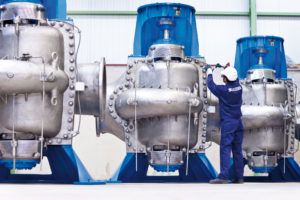SPECIFYING PUMPS
FACTORS TO CONSIDER IN CENTRIFUGAL PUMP SELECTION AND DESIGN FOR POWER GENERATION
By Gary Fitch

Sulzer Pumps, PU, Burgos, Spain, Hidrotecar[/caption]
Centrifugal pumps make up nearly three quarters of the industrial pumps in use today. They are commonly used in the power generation sector. However, they must be correctly specified and maintained to deliver efficient and reliable service.
This process of specification begins with understanding the basic terminology, principles and design characteristics to ensure each pump is able to meet its potential and deliver the required performance.
Every pump has a performance graph that should be used to determine the suitability of the pump for a particular application. For a range of flows the graph indicates the generated head, power requirement, efficiency and the net positive suction head required (NPSHr).
Each pump design has an optimum flow rate which occurs at the best efficiency point (BEP). Either side of this are the normal operation conditions (80-110% BEP) and the preferred operating region (70-120% BEP) in this example. Pump efficiency is a crucial factor when designing a pumping system since 95% of the lifetime costs for a pump will be the energy it uses (Figure 1).
It is therefore important to correctly specify any new pump and ensure that the performance of existing pumps is checked when the operating characteristics of an application are changed. A pump assessment should be conducted to determine areas of potential savings as well as reduce payback periods for additional investments.
The system curve is equally important when defining the correct pump for an application. In addition to the pump, every system will incur additional frictional losses from piping, valves, strainers and reducers. These losses are proportional to the square of the flowrate and are measured in feet/head or meters/head.
The overall system curve is comprised of the frictional resistance and the static head, which is the net difference in height between the suction liquid level and the discharge liquid level. Pump designers use both the system curve and the pump curves, along with addition information, such as fluid specific gravity and viscosity to select the most appropriate pump for an application.
In some situations, the specification of a centrifugal pumping system will involve multiple pumps, either in parallel or series configurations. This enables smaller pumps to deliver much greater flow or head, depending on the pump arrangement, which may be preferable to a large single pump.
When working with pumps in series, it is important to understand that although the pumps may be hydraulically the same, designs may be different. Any pump located upstream of the initial pump will be operating at a higher pressure. Castings, shaft diameter and pipework will need to be correctly rated for the higher pressure.

SULZER AR 2011 PU BURGOS SPAIN[/caption]
Specific speed
Pumps are classified by specific speed, a dimensionless quantity that describes the geometry of the pumps impeller. Specific speed is a correlation of pump capacity, head and speed at optimum efficiency, which classifies pump impellers with respect to their geometric similarity.
The specific speed of an impeller is defined as the revolutions per minute at which a geometrically similar impeller would run if it were of such a size as to discharge one gallon per minute against one foot of head. Similarly, the suction specific speed indicates the relative ability of centrifugal pumps to operate under low NPSHa conditions.
Pumps with a specific speed of around 500 have radial flow impellers that produce high head but lower flow rates. In contrast, an axial flow impeller with a specific speed of 10,000 will produce high flow rates and low heads.
Avoiding problems
A correctly specified centrifugal pump should deliver decades of reliable service. However, one common problem is cavitation.
When a liquid enters a centrifugal pump, pressure drops as it flows from the suction flange through the suction nozzle and into the suction eye of the impeller. The amount of pressure drop is a function of factors including pump geometry, rotational speed, frictional losses, hydraulic shock losses and flow rate. If the pressure within the pump falls below the vapor pressure of the liquid being pumped at any point, vaporization or cavitation will occur.
Typically, cavitation is brought about by a reduction in suction head. It is initially signaled by the formation of vapor bubbles that cause an increase in vibration levels and a slight increase in pump noise. Gradually, the output head drops.
At 3% the drop is considered as a readily measurable datum point for the pump suction performance. After this point, the pump becomes noisy, full cavitation is initiated and the output head drops dramatically.
Every pumping application, therefore, contains its own challenges. It is the task of the pump designer to deliver the optimum solution. Centrifugal pumps will often provide the best answer, but their internal design and external dimensions determine their effectiveness and efficiency. ■
Gary Fitch is Head of Advance Engineering for Oil & Gas at Sulzer Pumps (US). Sulzer offers expertise in modern pump design as well as experience and knowledge in modifying older designs to handle process changes. For more information, www.sulzer.com